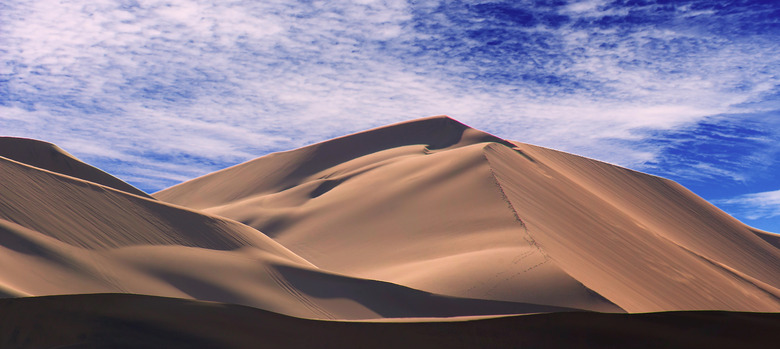Rainfall In Deserts
Deserts are some of the most inhospitable places on earth. They are very dry, have very poor soil, and can experience wildly varying temperature extremes. The Atacama desert in the Andes mountains of South America is so dry it experiences less than .01 cm of rain per year on average, and some areas can go years without any rain at all. Yet even these arid places have some water, and will support some life.
What is a Desert?
What is a Desert?
According to the United States Geological Survey, a desert is a place that qualifies as either arid or extremely arid, following a system set forth in 1953 by Peveril Meigs. An arid area receives less than 25 cm of rain per year. An extremely arid area is defined as an area that regularly goes more than 12 consecutive months without any rain at all.
Common Misconceptions
Common Misconceptions
There are several common misconceptions regarding deserts. One is that they must be hot. This is not so. The lack of moisture is the defining factor. Some deserts are temperate or even frigid. The Atacama Desert in South America lies almost entirely high in the Andes Mountains, and has an average daily temperature between 0 and 25 degrees Celsius. Temperatures often fall below freezing. Even some areas in the Arctic and Antarctic circles qualify as desert. Some deserts with daytime temperatures that are very hot can have nighttime temperatures close to freezing, like the Sonoran Desert in Arizona. Another common misconception is that deserts are just vast areas of sand dunes, devoid of life. In fact, some desert areas are composed of large areas of dunes, but many are much more geographically diverse, the landscape being comprised of scrub, rocky and gravelly areas with sparse vegetation. All deserts harbor life. Many types of insects, plants, reptiles and small mammals and birds call deserts home all over the world. These life forms have adapted to the desert's harsh conditions and have come to thrive there.
Rainfall in Deserts
Rainfall in Deserts
Some deserts, like the driest in the world, the Atacama, receive little or no rain. These places are extremely arid, and very little life exists there. Other deserts like the Sonoran Desert in Arizona receive close to the maximum yearly rainfall for deserts and are fairly well populated with many types of fauna and flora. The Sonoran Desert, while still arid, is lush compared to other deserts, supporting over 2,000 species of plants. Rains in the spring produce incredible flushes of greenery and flowers as the plants, dormant for most of the year, take advantage of the rain. Saguaro cacti reach enormous size, collecting and storing immense amounts of water when it does rain, and surviving for months until the next rainfall.
Frequency of Rain
Frequency of Rain
Most deserts get what little precipitation they do receive in a few, heavy rainfalls, rather than many light rains spread out over the course of the year. This leads to seasonal lakes and rivers which may last a few months, or even only a few days. Dry river beds are a common sight in many deserts, and are called wadis in some African and Middle Eastern deserts. Some rainfalls may bring torrents of 5 to 10 cm of rain in a few hours, leading to flash flooding in ravines or canyons, a seemingly paradoxical occurrence in the driest places on Earth. Arctic and Antarctic deserts receive their precipitation almost entirely as snow.
Factors Affecting Rainfall
Factors Affecting Rainfall
Many factors affect precipitation in deserts. Mountains often cause an effect called "rainshadow." This effect causes moisture-laden air to release its water on one side of a mountain range, contributing to desert on the other side. Atmospheric conditions such as pressure can also contribute to deserts. Lack of available surface water for evaporation in areas near deserts also has an effect.
Cite This Article
MLA
Petersen, Christian. "Rainfall In Deserts" sciencing.com, https://www.sciencing.com/rainfall-deserts-6632010/. 22 November 2019.
APA
Petersen, Christian. (2019, November 22). Rainfall In Deserts. sciencing.com. Retrieved from https://www.sciencing.com/rainfall-deserts-6632010/
Chicago
Petersen, Christian. Rainfall In Deserts last modified March 24, 2022. https://www.sciencing.com/rainfall-deserts-6632010/
